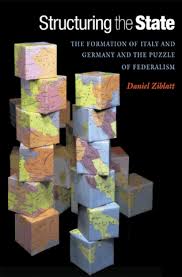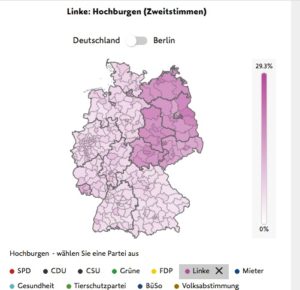At the start of the nineteenth century’s second half, Germany and Italy were both patchworks of states; by century’s end, both were united kingdoms taking their place among Europe’s great powers. Similar ideas drove the leaders of unification in both regions, yet the states that emerged from the wars and negotiations were quite different. Though both were monarchies, Germany had a strongly federal structure, with an upper house representing its constituent states, significant financial responsibility at the state level, and even included semi-autonomous army units from the kingdoms of Bavaria, Saxony and Württemburg that had been incorporated into the German Empire. Italy, by contrast, was a unitary state along French lines. The Italian regions, the Papal States, polities that had been jealous of their independence for centuries were subsumed into Piedmont’s rule, with practically no trace of their structures left in the new Kingdom of Italy. Why did two similar processes end so differently?
Daniel Ziblatt’s brief book (152 pages of primary text) looks at the historical and political science literature on the subject, at least as it stood when his book was published in 2006, and finds that the prevalent explanations do not adequately answer the question. He finds that Prussian and Piedmontese leaders held similar ideas about the desirability of federal solutions to the challenges of governing Germany and Italy. Bismarck and Cavour were both well aware of the significant differences among the regions of the nations they sought to unify; they knew the loyalties commanded by local identities. Both wrote that a centralized state modelled on post-Napoleonic France would not be ideal. Thus ideology could not be the main reason that the outcomes differed so strongly.
Some of the literature on state formation assigned a crucial role to military strength. The greater the military strength of the unifying group, the more it will be able to impose its will on the constituent parts, and the more likely it is to dominate the resulting state. This argument clearly does not apply to the cases of Germany and Italy. The disparity between Prussia and the other German states was much greater than the difference between Piedmont and, for example, the Kingdom of the Two Sicilies. Yet it was the smaller military that won the unconditional surrender of its regional competitors.
Ziblatt finds the answer in something of a paradox. The weaker capacity of the Italian states made them vulnerable, and when Piedmont achieved victory — whether on the field of battle or in diplomatic negotiation — it had no credible partners with which to construct a federal arrangement. The Kingdom of the Two Sicilies is instructive. Garibaldi’s revolutionary invaders were in theory far fewer than the Kingdom’s army. In practice, however, support for the Bourbon monarchy had eroded so thoroughly the island of Sicily was taken with little resistance. The fall of the monarchy in the rest of the kingdom soon followed. Civil disorder and rapidly rising crime led to calls for Piedmont to annex the territory and bring troops, police and administrators. Despite their inclination toward federalism, Piedmontese leaders saw little choice but to extend their laws and institutions to the conquered territory. Similar stories could be told for Lombardy and Tuscany. When their Austrian-supported rulers were toppled, there was not enough of a government left for Piedmont to make a deal with.
The German states, by contrast, had sufficient capacity to become partners — even if distinctly junior partners — with Prussia in the creation of the German Empire. The constitutional structure of the Empire recognized the continued existence and importance of its constituent parts. These retained some of their financial authority and much of their administrative responsibility. Part of German federalism that continues into the present, nearly a century and a half later, is that many laws are made nationally but implemented via the states. The German states that formed the Empire, especially the larger ones such as Saxony or Bavaria, retained their identities and administrations. To this day, Bavaria has a separate Christian Democratic party that only operates in the state, and the national Christian Democrats do not campaign in Bavaria.
Ziblatt closes the book with an examination of his thesis about state capacity and federalism in the formation of other Western European states. In general, it holds true, though of course some cases fit better than others.
Questions that he raises about Italy struck me as applying to German state formation at a much later date; namely, the incorporation of East Germany into the Federal Republic on October 3, 1990. “In September and October 1860 a new and important issue confronted the Piedmontese state-builders, an issue that confronts any state-building elite upon either negotiating or conquering new territory: what formal procedure should be used to incorporate the annexed territory? Put in other terms, how should the approval of southern Italians to carry out unification be determined? How is legitimacy for the new political entity to be achieved?” (p. 100)
Ziblatt points to three factors that pushed Piedmont toward rapid annexation: first, “the Piedmontese destruction of the Bourbon political leadership;” second, “the collapse of the Bourbon regime and the flight of the Bourbon King;” and third, without an already-existing parliament in Italy’s south, there was no organized ‘voice’ for southern Italian interests.” (p. 100) The situation in the German Democratic Republic between the fall of the Berlin Wall in November 1989 and the accession of the GDR’s component states to West Germany on October 3, 1990 has noticeable parallels. In the autumn of 1989, Communist regimes across Central Europe were falling. This corresponds to the collapse of Austria support for the absolutist states in Italy. On October 17, Erich Honecker was pushed out of the Politburo after 18 years atop the Communist Party. The ersatz monarch had been toppled. East Germany did have a parliament. In its only free election, in March 1990, the largest share of seats was won by an alliance whose main position was rapid unification with West Germany.
In contrast to the negotiations that produced first the North German Confederation and then the German Empire, the negotiations about the end of East Germany were about accession to an existing polity. From the election of the final Volkskammer to accession, reunification took less than six months; the Wall had fallen less than a year earlier. The states of East Germany — hastily reconstituted after having been dissolved for 37 years — merged into West Germany less than two weeks later.
Like their Piedmontese counterparts more than a century earlier, West German leaders had to make choices about unity in the face of state collapse in their former adversaries. In late 1989 and early 1990, East Germany had no legitimacy. Tens of thousands of people were leaving it every month. At that point, reunification was always going to be rapid and almost entirely on West German terms. Nearly 30 years later, though, distinctly Eastern voting patterns are visible; views on a wide range of political issues differ between the former East and the former West. German federalism functions; the institutional questions are settled, but questions of belonging remain, and they show up in polls and at the ballot box. As with Piedmont, decisions taken in haste and under great pressure have long-lasting consequences.


